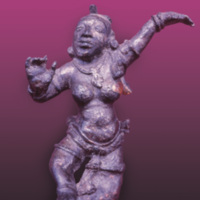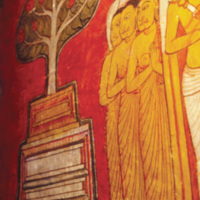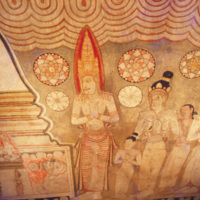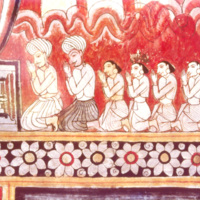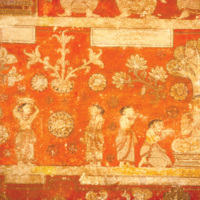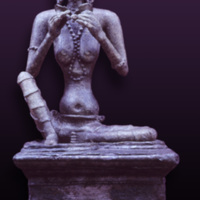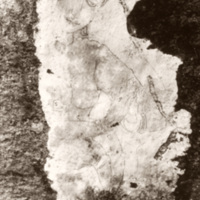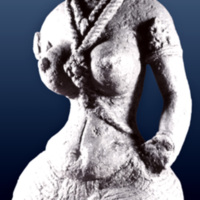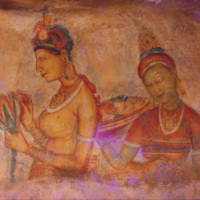Main Menu
AORC Libraries
Browse Archive Items (166 total)
A bronze statuette of a dancing girl
Description: This bronze figure of a female dancer was found at the Kuttampokuna or Twin ponds of the Abhayagiri monastery at Anuradhapura, Sri Lanka. Some authorities believe that it was a part of a chain suspending an oil lamp. It is important to note that female dancers were considered appropriate as decorative devices in buildings associated with monasteries during the mid-Anuradhapura period to which this bronze may be assigned.
Contributor: Co-Author: Seneviratna, Harsha
Collection: Women in Sri Lankan Sculpture and Painting
Tags: AISLS, ICES, PDWESLSP, Women in music and dance
Women in music and dance
Description: Women in music and dance: Music and dancing were considered special accomplishments of women. Appearing as they do in temple sculpture and painting, it is mostly the devotional aspect of these art forms that is represented. However, one does also notice the purely decorative use of the female dancer in art. The expression of bhakti or devotion through music and dance is common to both Buddhist and Hindu forms of worship. Their incidence is more pronounced in the Polonnaruva and post-Polonnaruva…
Contributor: Co-Author: Seneviratna, Harsha
Collection: Women in Sri Lankan Sculpture and Painting
Tags: AISLS, ICES, PDWESLSP, Women in music and dance
Bhikkhunis bringing a sapling of the Bodhi tree to Sri Lanka from India
Description: The only illustration in art of Bhikkhunis or Buddhist nuns during the period covered by this survey is seen at Dambulla. This painting shows the arrival of bhikkhuni Sanghamitta (the founder of the order of Buddhist nuns in Si Lanka) together with her companions, bringing with them a sapling of the Bodhi tree, the tree under which the Buddha attained enlightenment.
Contributor: Co-Author: Seneviratna, Harsha
Collection: Women in Sri Lankan Sculpture and Painting
Tags: AISLS, ICES, PDWESLSP, The female as religious devotee
A royal group worshipping at a Buddhist stupa
Description: This scene, from the Dambulla cave paintings, shows the family of Dutthagamini (a popular Sri Lankan King of the 2nd century B.C.E.) together with god Sakra worshiping at the Ruvanvelisaya, Sri Lanka. It is noteworthy that the queen stands in front of the King.
Contributor: Co-Author: Seneviratna, Harsha
Collection: Women in Sri Lankan Sculpture and Painting
Tags: AISLS, ICES, PDWESLSP, The female as religious devotee
Women behind men worshipping at a Buddhist temple
Description: Among the cave paintings of Dambulla, which have been dated to the 18th century by art historians, is this illustration of four female devotees, seated behind two men, worshipping the Buddha.
Contributor: Co-Author: Seneviratna, Harsha
Collection: Women in Sri Lankan Sculpture and Painting
Tags: AISLS, ICES, PDWESLSP, The female as religious devotee
Sujatha, a female devotee of Buddha
Description: An episode in the life of the Buddha picked out as worthy of illustration by painters of the Kandyan period (18th to early 19th century A.D.) is the offering of alms by Sujatha. She would have been considered typical of the average female lay devotee. This painting is from the Gangarama Vihare near Kandy, Sri Lanka.
Contributor: Co-Author: Seneviratna, Harsha
Collection: Women in Sri Lankan Sculpture and Painting
Tags: AISLS, ICES, PDWESLSP, The female as religious devotee
A female devotee of God Siva
Description: This seated female bronze statue from Padaviya, Sri Lanka is that of Karaikkalammayyar, traditionally considered to be a devotee of Siva. Playing a pair of cymbals, her devotion is expressed through music. The statue which is at the Archaeological Museum, Anuradhapura, Sri Lanka has been dated to a period between the 11th and 12th centuries A.D. by archaeologists.
Contributor: Co-Author: Seneviratna, Harsha
Collection: Women in Sri Lankan Sculpture and Painting
Tags: AISLS, ICES, PDWESLSP, The female as religious devotee
A painting of a female devotee
Description: This slide is made from a photograph available at the Department of Archaeology in Colombo. Seen at Gonagala, Ampara, Sri Lanka. It is a section of a cave painting where a female devotee stands in a dance posture. She is worshiping a male figure, no doubt a deity. The painting has been attributed to the 8th century A. D. by scholars.
Contributor: Co-Author: Seneviratna, Harsha
Collection: Women in Sri Lankan Sculpture and Painting
Tags: AISLS, ICES, PDWESLSP, The female as religious devotee
Terra-cotta models of women painted on the Sigiriya rock
Description: Terra-cotta models of the Sigiriya women were sculpted in subsequent times. They were probably meant to be souvenirs for visitors to Sigiriya, Sri Lanka. This torso was found during excavations associated with the Cultural Triangle Project at Sigiriya, and can be seen at the Project Museum.
Contributor: Co-Author: Seneviratna, Harsha
Collection: Women in Sri Lankan Sculpture and Painting
Tags: AISLS, ICES, PDWESLSP, The female as religious devotee
Sigiriya paintings- women carrying flowers
Description: The paintings of women carrying flowers, probably for worship, at Sigiriya, Sri Lanka, belong to the period of Kasyapa I, in the 5th century A.D.
Contributor: Co-Author: Seneviratna, Harsha
Collection: Women in Sri Lankan Sculpture and Painting
Tags: AISLS, ICES, PDWESLSP, The female as religious devotee



